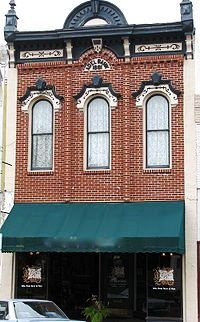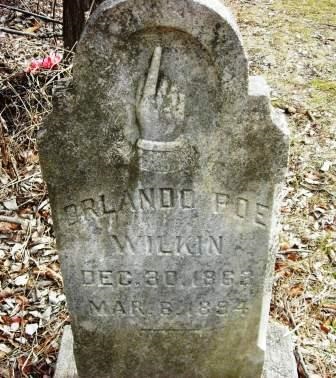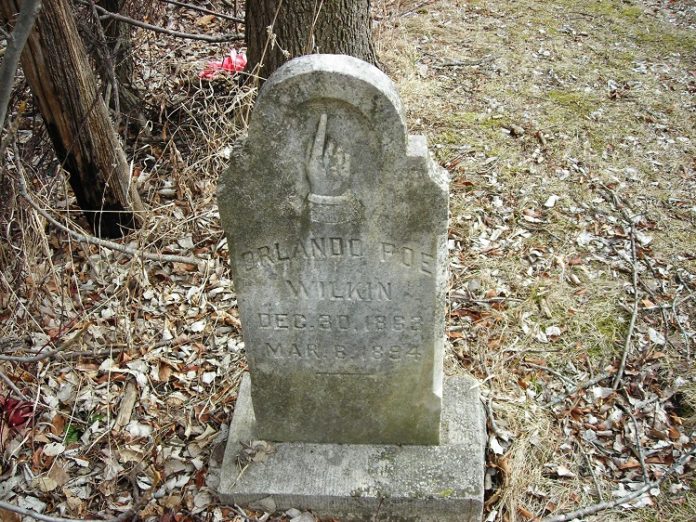A bloody robbery of the Adel State Bank took place March 6,1895, and was one of the most violent events in Dallas County history. The robbery left one man dead and six others wounded.

The Adel State Bank was organized by Samuel Leach and a Dr. Caldwell in 1882. It bank was one of the leading financial institutions of the county, with deposits amounting to nearly $350,000. It was on the west side of the square where the Cameo Rose store was located.
The robbers, Orlando “Rowdy” Wilkins and Charles Crawford, were from Patterson, Iowa. Wilkins had just been released from prison in Minnesota and needed funds. They had planned to rob the bank in Indianola, but Crawford had gotten cold feet and refused to take part.
Crawford eventually got his nerve back and agreed to help rob the Adel bank.
The men spent the night at a farmhouse south of Adel. On the morning of the robbery, Wilkins and Crawford drove a team and buggy into Adel and tied the horses at 9th and Court Street. They entered the bank around 9 a.m.
Wilkins was carrying a Spencer repeating shotgun that held multiple shells and had a pump action. S.M. Leach, the cashier, was working at the counter, sorting money for the day’s business. He didn’t look up but asked the men if he could help them.
Wilkins stuck the gun in his face and said, “Shell out.” Leach tried to take the money back to the vault, and Wilkins shot him twice in the shoulder and neck area. A customer in the bank, C. D. Bailey, tried to stop Wilkins, but he was shot as well. The robbers grabbed a bag and filled it with silver. They got away with about $267.
The shooting attracted attention both inside and outside the bank. The office above the bank was occupied by a lawyer named George Clarke. Hearing the shots, Clarke came down the stairs where Wilkins was waiting. Wilkins stuck his shotgun into Clarke’s chest and pulled the trigger.
The gun clicked but did not fire, and Clarke hurried back up the stairs, lucky he hadn’t been killed. It is interesting to note that George Clarke later became the governor of Iowa. He was also the grandfather of Nile Kinnick. How history would have been changed if that gun had not misfired!
Sheriff J. D. Payne heard the shots and was on his way. There were other armed men who had heard the shots as well, and they exchanged gun fire with the outlaws. Four other men — Robert Barr, J. L. Simcoke, J. M. Byers and Cecil Decker — were wounded but none as seriously as Leach and Bailey, who were thought to be dying from their wounds.
Wilkins and Crawford made it to their team and took off at breakneck speed, heading west on Court Street. They went west as far as they could and then south to the road leading west out of Adel. A posse was formed and three men, Tom Reynolds, Don Snyder and Charles Worford, followed the robbers out of town and kept them in sight.
Wilkins and Crawford went west to where the Triangle Inn would have been and turned south on the road which today is P-58. They continued south and then east on what today is 330th Street. It was in this area that a well-placed shot by Charles Kissick wounded one of the horses pulling their buggy. Wilkins and Crawford fled on foot and separated at a place called O’Neal’s Crossing.
It wasn’t long before Crawford was caught.
Wilkins took refuge in the O’Neal barn. He refused to come out, and gunfire was exchanged. The posse forced Crawford to take a can of kerosene and douse a straw stack next to the barn. He then lit the straw and barn on fire. With the barn ablaze, Wilkins tried to make a run for it but was shot down by a well-known farmer named Pritchard.
The men in the posse then lost control of their emotions and riddled the body of Wilkins with bullets.
Crawford and the body of Wilkins were taken back to Adel. The bag of silver coins was found in a ditch along the side of the road where the outlaws had tossed it during their attempt to escape.

Before being taken to the undertaker, Wilkins’ bullet-riddled body was displayed in a chair in front of the bank so the public could view the dead outlaw.
This custom was used to show that crime, indeed, did not pay. Wilkins was buried at Oakdale Cemetery on Adel’s north side.
Crawford was taken to the Dallas County Jail. On the night of March 6, a very large crowd with rifles, pistols and clubs gathered in the streets of Adel. They wanted to lynch Crawford for his role in the bank robbery.
Lynching was not uncommon in Iowa, with justice at the end of a rope sometimes sought by unhappy townsfolk with uncontrolled emotions.
Fortunately for Crawford, Sheriff Payne had anticipated trouble and had extra guards posted at the jail. The sheriff still had to do some pretty serious talking with the mob. Cooler heads prevailed, and the mob went home. It helped when they were told that Leach and Bailey were going to survive the wounds suffered in the bank robbery.
Crawford was found guilty and sentenced to 12 years in prison. He served his time and later came back to Adel and worked there. The townspeople who were wounded all recovered.
The shotgun used in the robbery is on display at the Adel Historical Museum although the wooden part of the gun was destroyed in the fire at the barn. Also in the Adel Museum is the front of a teller’s cage that came from the Adel State Bank. If you want to see these artifacts as well as many others from Adel’s history, visit the Adel Historical Museum at 1129 Main St. in Adel or give Jan Price a call at the museum at 515993-1032.

















